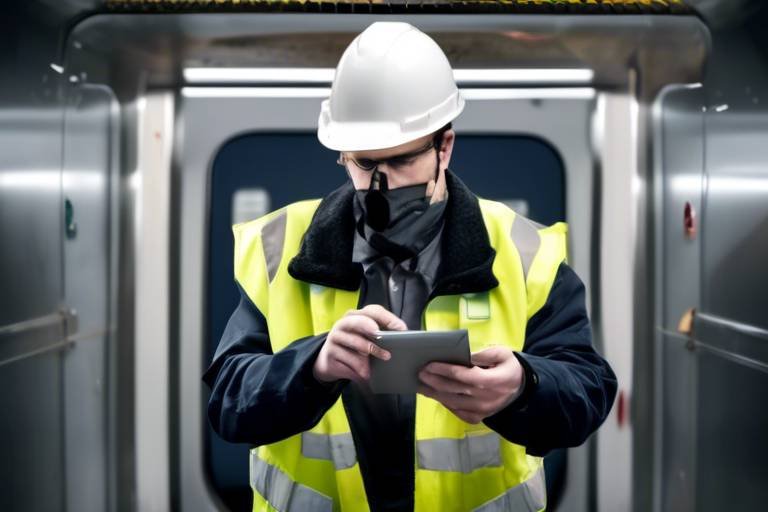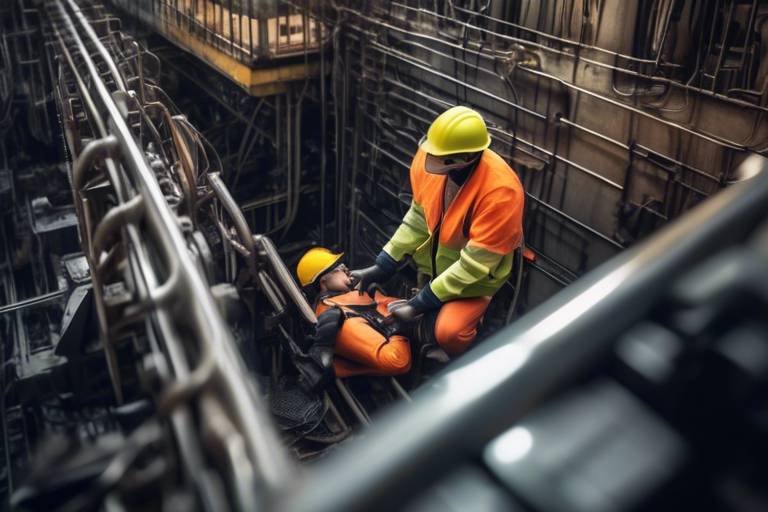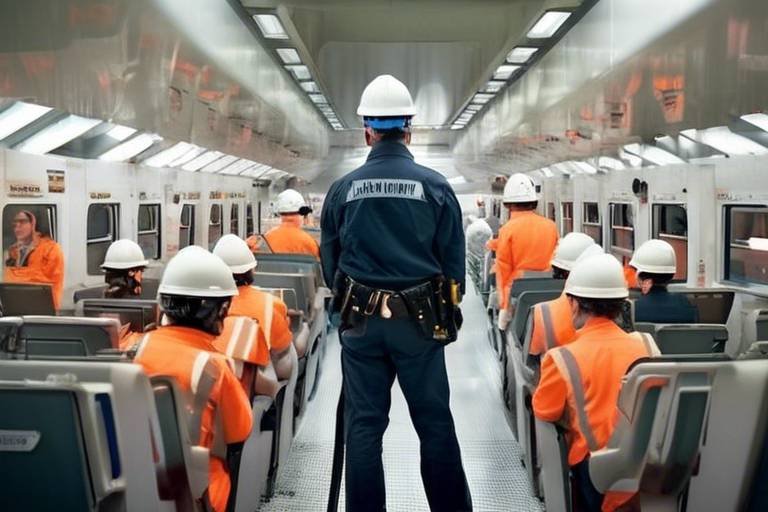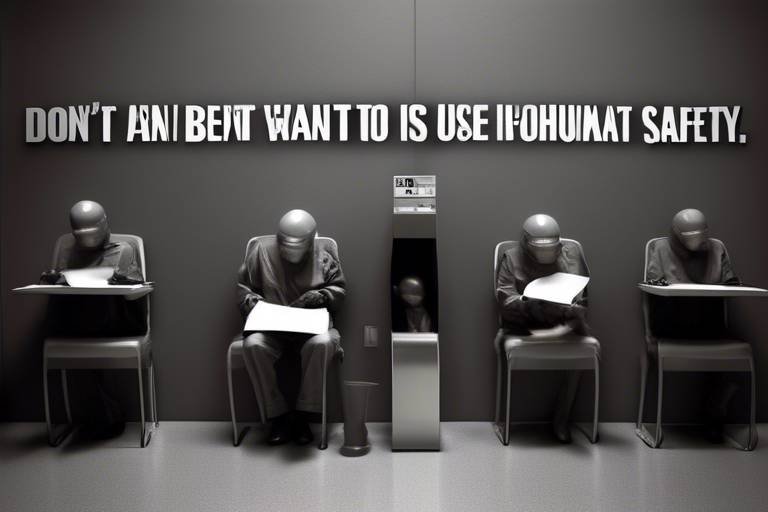How Understanding Human Behavior can Reinforce Safety Protocols
In today's world, where safety protocols are more crucial than ever, understanding human behavior can be the secret ingredient that transforms compliance from a mere obligation into a genuine commitment. Imagine walking into a workplace where everyone not only knows the safety rules but actively embraces them. This isn’t just a dream; it’s a reality that can be achieved by tapping into the psychology behind why people act the way they do. By examining the intricate relationship between human behavior and safety protocols, organizations can create environments that are not only safer but also more engaging for everyone involved.
At the heart of this exploration lies the notion that safety is not just a set of rules to follow but a culture to cultivate. When employees understand the why behind safety measures, they are more likely to comply. This understanding can lead to a significant shift in mindset, where safety becomes a shared responsibility rather than a top-down directive. For instance, consider a scenario where a team member speaks up about a potential hazard. This act not only protects their colleagues but also fosters a culture of openness and vigilance. In this way, understanding human behavior can be the catalyst for reinforcing safety protocols across various settings, from construction sites to corporate offices.
Moreover, the integration of psychological insights into safety training can lead to innovative strategies that resonate with individuals on a personal level. Think about it: when safety training is tailored to address specific behavioral triggers, it becomes more relevant and impactful. For example, if an organization recognizes that fear of accidents is a strong motivator for compliance, they can design interventions that highlight the real-life consequences of neglecting safety protocols. This approach not only informs but also emotionally engages employees, making them more likely to adhere to safety measures in their daily routines.
The journey towards a safer environment is not just about enforcing rules; it’s about creating a community where safety is a collective value. By understanding the nuances of human behavior, organizations can develop strategies that not only promote compliance but also inspire individuals to take ownership of their safety and that of their peers. This shift from obligation to ownership can lead to a profound transformation in how safety protocols are perceived and followed. Ultimately, when individuals feel personally invested in safety, the entire organization benefits from a culture that prioritizes well-being as a fundamental principle.
- Why is understanding human behavior important for safety protocols?
Understanding human behavior helps tailor safety strategies that resonate with individuals, leading to greater compliance and a stronger safety culture. - How can organizations motivate employees to follow safety protocols?
By using intrinsic and extrinsic motivators, organizations can encourage individuals to prioritize safety in their actions and decisions. - What role does leadership play in fostering a safety culture?
Leadership sets the tone for safety practices and influences employee attitudes toward compliance, making it crucial for cultivating a safety culture. - How can gamification enhance safety training?
Gamification transforms safety training into engaging experiences, enhancing motivation and participation among employees.

The Psychology of Compliance
Understanding the psychology behind why people comply with safety protocols is like unlocking a treasure chest of insights that can lead to safer environments in workplaces and public spaces. It's not just about rules and regulations; it's about the intricate web of human behavior, perceptions, and motivations that drive compliance. When we delve into the psychological factors influencing adherence, we begin to see that compliance is often rooted in a mix of personal beliefs, social influences, and environmental cues.
One of the key elements in this landscape is the concept of perceived risk. When individuals recognize the potential hazards associated with their actions, they are more likely to follow safety protocols. For instance, if a worker understands that not wearing a helmet increases their risk of injury, they are more inclined to comply with the safety guideline. This highlights the importance of effective communication in conveying the risks involved in various activities. Organizations must ensure that safety messages are clear, relatable, and resonate with the audience.
Moreover, the role of social norms cannot be underestimated. People are inherently social beings, and their behaviors are often influenced by those around them. If an employee observes their peers consistently adhering to safety protocols, they are more likely to follow suit. This creates a ripple effect where compliance becomes a collective norm. Organizations can leverage this by fostering an environment where safety is not just an individual responsibility but a shared value among all members.
Another fascinating aspect is the power of reinforcement. Positive reinforcement, such as recognition or rewards for safe behavior, can significantly boost compliance rates. When individuals feel appreciated for their adherence to safety protocols, it reinforces their behavior and encourages them to continue prioritizing safety. Conversely, negative reinforcement or punishment can lead to resentment and disengagement, which ultimately undermines compliance efforts.
In addition to these factors, understanding the different types of motivation—intrinsic and extrinsic—is crucial. Intrinsic motivation stems from personal satisfaction and internal values, while extrinsic motivation is driven by external rewards or pressures. By identifying what motivates individuals within an organization, safety initiatives can be tailored to effectively resonate with their values and encourage compliance. For example, an organization might implement a safety challenge where employees earn points for adhering to protocols, appealing to both intrinsic and extrinsic motivations.
In summary, the psychology of compliance is a multifaceted domain that encompasses risk perception, social influences, reinforcement, and motivation. By tapping into these psychological principles, organizations can develop more effective strategies to promote adherence to safety protocols, ultimately creating a safer environment for everyone involved.
- What is the importance of understanding human behavior in safety protocols? Understanding human behavior helps organizations tailor safety strategies that resonate with individuals, increasing compliance and enhancing overall safety.
- How can social norms influence safety behavior? Social norms create a collective expectation for behavior; when employees see their peers following safety protocols, they are more likely to do the same.
- What role does motivation play in compliance? Motivation, whether intrinsic or extrinsic, significantly impacts an individual's likelihood to adhere to safety protocols, making it essential to understand and address these factors.
- How can organizations reinforce safe behavior? Organizations can reinforce safe behavior through positive recognition, rewards, and cultivating a culture of safety where adherence is valued and celebrated.

Behavioral Triggers for Safety
When it comes to safety protocols, understanding the behavioral triggers that prompt individuals to comply can be a game-changer. Imagine walking into a workplace where safety is not just a set of rules, but a way of life. This transformation doesn’t happen by accident; it requires a keen insight into what makes people tick. By identifying specific triggers—those little nudges that push individuals toward safe practices—organizations can create interventions that not only encourage adherence but also foster a culture of safety.
One of the most powerful triggers is the environment itself. Think about it: a cluttered workspace can lead to accidents, while a clean, organized area promotes safety. This is where visual cues come into play. For example, strategically placed signs reminding employees to wear helmets or safety goggles can significantly increase compliance. These visual reminders act as constant nudges, keeping safety at the forefront of everyone’s mind.
Another critical aspect is the role of peer influence. Humans are social creatures, and our behaviors are often shaped by those around us. If a team member consistently follows safety protocols, others are likely to follow suit. This creates a ripple effect, reinforcing safe behaviors throughout the organization. To capitalize on this, organizations can implement team-based challenges that encourage collective adherence to safety practices. When everyone is in it together, compliance becomes a shared goal rather than an individual task.
Moreover, understanding the timing of interventions can enhance their effectiveness. For instance, conducting safety briefings right before a shift begins can remind employees of the protocols they need to follow throughout the day. This timing ensures that safety is top of mind as they start their work, reducing the likelihood of accidents. Additionally, using real-life scenarios during training sessions can prepare employees for potential hazards they may face, making them more likely to adhere to safety measures when it matters most.
It’s also essential to recognize that different demographics may respond to triggers in various ways. For example, younger employees might be more motivated by gamification elements, while seasoned workers may appreciate straightforward, no-nonsense reminders. Tailoring safety interventions to fit the unique characteristics of your workforce can enhance their effectiveness. A well-designed program considers these differences and adjusts its approach accordingly.
In conclusion, by identifying and leveraging behavioral triggers, organizations can create a more robust framework for safety compliance. Whether it’s through environmental cues, social influences, timing of interventions, or demographic considerations, these triggers can significantly impact how individuals perceive and adhere to safety protocols. The ultimate goal is to create an environment where safety is not just a requirement but a fundamental aspect of daily operations.
- What are behavioral triggers for safety?
Behavioral triggers for safety are specific cues or influences that prompt individuals to adhere to safety protocols. These can include environmental factors, peer behaviors, and timing of reminders. - How can organizations identify these triggers?
Organizations can conduct surveys, focus groups, and observational studies to understand what influences their employees' safety behaviors. - Why is peer influence important in safety compliance?
Peer influence is crucial because individuals are likely to mimic the behaviors of those around them, creating a culture of safety when positive behaviors are modeled.

Motivation and Incentives
When it comes to adhering to safety protocols, the role of motivation and incentives cannot be overstated. Understanding what drives individuals to prioritize safety can lead organizations to craft strategies that resonate deeply with their workforce. Imagine a workplace where every employee feels a personal stake in safety—not just because they have to, but because they want to. This shift in mindset can transform compliance from a mere obligation into a shared value.
At the heart of this transformation lies the concept of motivation. It can be broadly categorized into two types: intrinsic and extrinsic. Intrinsic motivation is the internal drive to engage in an activity for its own sake, such as a genuine concern for personal and colleague safety. On the other hand, extrinsic motivation involves external rewards, such as bonuses or recognition for adhering to safety protocols. Both types can be powerful, but understanding how they interact is crucial.
For instance, consider a scenario where a company implements a safety program that not only educates employees about the protocols but also rewards them for their adherence. This could include:
- Monthly safety awards for individuals or teams
- Public recognition during company meetings
- Incentives such as gift cards or additional time off
These incentives can create a culture where safety is celebrated, making it more likely that employees will engage in safe practices. However, it’s essential to strike a balance. Over-reliance on extrinsic rewards might diminish intrinsic motivation in the long run, as employees could become conditioned to follow safety measures only for the rewards.
Furthermore, gamification has emerged as a compelling method to enhance motivation. By turning safety training into an engaging game-like experience, organizations can tap into employees' competitive spirits. Imagine a leaderboard where teams earn points for completing safety tasks or participating in training sessions. This creates a fun environment that encourages participation and fosters a sense of community around safety.
Ultimately, the key is to create a comprehensive approach that combines both intrinsic and extrinsic motivators. By doing so, organizations can cultivate an environment where safety is not just a protocol to follow but a core value embraced by everyone. This holistic strategy not only enhances compliance but also contributes to a culture of safety that can significantly reduce workplace accidents and injuries.
- What is the difference between intrinsic and extrinsic motivation?
Intrinsic motivation comes from within an individual, driven by personal satisfaction, while extrinsic motivation is influenced by external rewards. - How can gamification improve safety compliance?
Gamification makes safety training engaging and fun, encouraging participation and fostering a sense of community. - What are some effective incentives for promoting safety?
Incentives can include recognition, rewards, and competitions that encourage adherence to safety protocols.

Intrinsic vs. Extrinsic Motivation
When we dive into the world of motivation, we find ourselves at a fascinating crossroads: intrinsic versus extrinsic motivation. These two types of motivation can significantly influence how individuals adhere to safety protocols. But what exactly do they mean? Think of intrinsic motivation as the fuel that comes from within. It’s that internal drive that makes you want to follow safety rules because you genuinely believe in their importance. For instance, an employee might wear protective gear not just because it's mandatory, but because they value their own health and safety, as well as that of their coworkers.
On the flip side, extrinsic motivation is like the shiny object dangling in front of you, often involving external rewards or pressures. This could be anything from bonuses for maintaining a safe workplace to penalties for failing to comply with safety regulations. While both forms of motivation can be effective, they often resonate differently with individuals. Some people thrive on the personal satisfaction of doing the right thing, while others respond better to tangible rewards or consequences.
To put it simply, intrinsic motivation is akin to planting a seed that grows into a strong tree, rooted in personal values and beliefs. Extrinsic motivation, however, is more like a balloon that can float away; it relies on external factors that can change over time. Understanding this distinction is crucial for organizations aiming to enhance safety compliance. By fostering a culture that promotes intrinsic motivation—where employees feel a sense of ownership and responsibility for their own safety—companies can create a more sustainable approach to safety protocols.
To illustrate the difference further, here’s a quick comparison:
| Intrinsic Motivation | Extrinsic Motivation |
|---|---|
| Driven by personal values and beliefs | Driven by external rewards or consequences |
| Leads to lasting behavior change | May result in temporary compliance |
| Fosters a deeper connection to safety practices | Can create a sense of obligation or pressure |
Incorporating both intrinsic and extrinsic motivation into safety initiatives can be a game-changer. For example, organizations can create programs that not only reward safe behaviors but also emphasize the personal benefits of adhering to safety protocols. This dual approach ensures that employees are not just following rules out of fear of punishment but are genuinely invested in maintaining a safe environment.
Ultimately, understanding the balance between intrinsic and extrinsic motivation allows organizations to tailor their safety protocols effectively. By promoting a culture that values both personal commitment and external incentives, companies can significantly enhance compliance and create a safer workplace for everyone.
- What is intrinsic motivation? Intrinsic motivation refers to engaging in a behavior because it is personally rewarding, leading to a genuine commitment to safety practices.
- What is extrinsic motivation? Extrinsic motivation involves performing a behavior to earn external rewards or avoid negative consequences, such as bonuses or penalties.
- How can organizations promote intrinsic motivation? Organizations can promote intrinsic motivation by fostering a culture of safety that emphasizes personal responsibility and the importance of safety practices.
- Can both types of motivation coexist? Yes, both intrinsic and extrinsic motivations can coexist and complement each other in promoting compliance with safety protocols.

Gamification of Safety Protocols
Imagine walking into a workplace where the air buzzes with excitement—not from the latest tech gadget, but from the implementation of safety protocols that feel more like a game than a chore. Gamification is the art of applying game-design elements in non-game contexts, and it’s transforming the way we approach safety protocols. By integrating elements such as points, badges, and leaderboards, organizations can turn mundane safety training into an engaging experience that not only captures attention but also enhances retention.
Why does this matter? Well, traditional safety training can often feel like a monotonous lecture, leaving employees disengaged and more likely to forget vital information. On the other hand, when safety practices are gamified, they become interactive and enjoyable. Employees are more likely to participate actively, which leads to a deeper understanding of safety measures. For instance, imagine a scenario where employees earn points for completing safety quizzes or for reporting unsafe conditions. This not only encourages them to learn but also fosters a sense of competition and camaraderie among colleagues.
To illustrate, let’s consider a simple table that outlines how gamification can be effectively integrated into safety protocols:
| Gamification Element | Purpose | Example |
|---|---|---|
| Points System | Encourages participation and learning | Employees earn points for attending safety meetings |
| Badges | Recognizes achievements | Badges for completing safety training modules |
| Leaderboards | Creates friendly competition | Top safety reporters displayed on a leaderboard |
Furthermore, gamification can also involve real-time feedback, allowing employees to see their progress immediately. This instant gratification can significantly boost motivation. For example, if an employee completes a safety drill simulation and receives immediate feedback about their performance, they are more likely to remember the lessons learned and apply them in real situations.
Moreover, gamified safety protocols can also facilitate teamwork. When employees work together to achieve common goals, such as completing a safety challenge, it fosters a culture of collaboration. This not only improves compliance but also strengthens relationships among team members, making safety a shared responsibility rather than a solitary task.
In conclusion, the gamification of safety protocols is not just a trend; it’s a revolutionary approach that aligns with modern learning preferences. By transforming safety training into an engaging, competitive, and collaborative experience, organizations can significantly enhance adherence to safety protocols. As we continue to explore innovative ways to keep our workplaces safe, gamification stands out as a powerful tool that can turn safety compliance into an exciting adventure.
- What is gamification? Gamification is the application of game-design elements in non-game contexts to enhance engagement and motivation.
- How can gamification improve safety training? By making training interactive and enjoyable, gamification increases participation and retention of safety information.
- What are some examples of gamification in safety protocols? Points systems, badges for achievements, and leaderboards for competition are common examples.
- Does gamification really work? Yes, studies have shown that gamification can lead to higher engagement levels and better retention rates in safety training.

Social Influence on Safety Behavior
When you think about safety protocols, do you ever consider the impact of your peers? It's fascinating how social influence can shape our behaviors, especially when it comes to adhering to safety measures. People are inherently social beings, often looking to others for cues on how to act. This phenomenon is particularly pronounced in workplace settings, where the actions of colleagues can either encourage or discourage compliance with safety protocols. Imagine a scenario where everyone in a team is wearing their safety gear; this collective behavior not only sets a standard but also creates a culture of safety that individuals are likely to follow.
Research shows that individuals are more likely to engage in safe practices when they see their peers doing the same. This is known as observational learning, and it plays a crucial role in shaping safety behavior. For instance, if a new employee observes their coworkers consistently following safety protocols, they are more inclined to adopt those same behaviors. Conversely, if they notice lax attitudes towards safety, they may feel it’s acceptable to do the same. This creates a ripple effect that can either strengthen or weaken the overall safety culture within an organization.
Moreover, the concept of social proof comes into play here. People tend to look to others when determining the right course of action, especially in uncertain situations. For example, if an employee sees that their team leader prioritizes safety by wearing protective equipment and following all protocols, they are likely to follow suit. This is why it's vital for organizations to not only train employees on safety protocols but to also encourage leaders to model these behaviors consistently. When leadership demonstrates a commitment to safety, it reinforces the message that safety is a shared responsibility.
In addition to leadership, peer support can be a powerful motivator for safety compliance. When team members hold each other accountable, it fosters an environment where safety is everyone's concern. Establishing buddy systems or safety champions within teams can enhance this accountability. For example, if each employee is paired with a buddy responsible for checking safety gear or reminding each other about protocols, it creates a sense of shared responsibility. This not only improves adherence but also builds camaraderie among colleagues.
Ultimately, understanding the dynamics of social influence can help organizations design interventions that promote safer practices. By creating a culture where safety is prioritized and modeled at all levels, companies can significantly enhance compliance with safety protocols. It’s about creating a community that values safety, where everyone feels empowered to speak up and take action. So, the next time you think about safety, consider the power of your social circle and how it can help shape a safer environment for all.
- What role does peer pressure play in safety compliance?
Peer pressure can either encourage or discourage adherence to safety protocols, depending on the behaviors exhibited by colleagues. - How can organizations enhance social influence for safety?
Organizations can enhance social influence by promoting leadership modeling, implementing buddy systems, and fostering a culture of accountability. - What is observational learning in the context of safety behavior?
Observational learning refers to the process by which individuals learn behaviors by watching others, which can significantly impact safety practices.

Training and Education Strategies
When it comes to ensuring safety in any environment, effective training and educational strategies are absolutely vital. Think of these strategies as the backbone of a robust safety culture, providing individuals with the knowledge they need to not only understand safety protocols but also to implement them consistently. Without proper training, even the best safety protocols can fall flat, as individuals may not grasp the importance of compliance or how to execute safety measures in real-life scenarios.
Imagine walking into a workplace where safety is treated like an afterthought. Employees are confused about the rules, and as a result, they may take unnecessary risks. On the flip side, a well-structured training program can transform that scenario. It can empower employees, making them feel confident and competent in their understanding of safety protocols. This sense of empowerment is crucial because it fosters a culture where safety is prioritized, not just a box to check off.
One effective approach to training is through interactive programs. These programs engage participants in a way that traditional lectures often fail to do. By incorporating hands-on activities, simulations, and real-life scenarios, individuals can practice what they learn in a safe environment. This kind of experiential learning not only enhances retention but also encourages active participation. When employees are actively involved in their training, they are more likely to internalize the information and apply it in their daily routines.
Moreover, establishing a culture of continuous learning is essential. Safety protocols are not static; they evolve as new information and technologies emerge. By providing regular updates and refresher courses, organizations can ensure that their employees remain informed and prepared. This ongoing education can be supplemented with feedback mechanisms that allow employees to voice their concerns and suggestions regarding safety practices. When individuals feel heard, they are more likely to engage with safety initiatives actively.
To illustrate the impact of continuous learning, consider the following table that outlines key components of effective training strategies:
| Training Component | Description |
|---|---|
| Interactive Learning | Engaging participants through hands-on activities and simulations. |
| Regular Updates | Providing ongoing education to keep employees informed about new safety protocols. |
| Feedback Mechanisms | Encouraging employees to share their thoughts on safety practices. |
| Real-Life Scenarios | Using practical examples to demonstrate the importance of safety protocols. |
Ultimately, the goal of these training and education strategies is to create a workforce that is not only knowledgeable but also motivated to prioritize safety. When employees understand the 'why' behind safety protocols and feel equipped to follow them, compliance becomes a natural part of their behavior. This shift in mindset is crucial for fostering a culture where safety is everyone's responsibility.
- What is the importance of training in safety protocols? Training ensures that employees understand and can effectively implement safety measures, reducing the risk of accidents.
- How can interactive training improve safety compliance? Interactive training engages employees and allows them to practice safety measures in realistic scenarios, enhancing retention and application.
- Why is continuous learning necessary in safety training? Continuous learning keeps employees updated on evolving safety protocols and reinforces their commitment to maintaining a safe environment.

Interactive Training Programs
In today's fast-paced world, traditional training methods often fall short. That's where come into play, revolutionizing the way we approach safety protocols. These programs are designed to engage participants actively, making learning not just informative but also enjoyable. Imagine a training session where employees are not just passive listeners but active participants, involved in discussions, simulations, and hands-on activities. This dynamic approach enhances retention and encourages individuals to internalize safety practices more effectively.
Interactive training programs often utilize various methods to keep participants engaged. For instance, role-playing scenarios can mimic real-life situations, allowing employees to practice their responses to potential hazards in a safe environment. This experiential learning not only boosts confidence but also helps in identifying gaps in knowledge that can be addressed immediately. Additionally, incorporating technology, such as virtual reality (VR) or augmented reality (AR), can create immersive experiences that make safety training memorable and impactful.
Furthermore, these programs can be tailored to meet the specific needs of different organizations. For example, a construction company might focus on fall prevention techniques, while a healthcare facility could emphasize infection control protocols. By customizing content, organizations can ensure that the training is relevant and applicable to the participants' daily tasks. This relevance is crucial because when employees see the direct connection between training and their work, they are more likely to engage and apply what they've learned.
Another significant advantage of interactive training is the opportunity for immediate feedback. Participants can ask questions, clarify doubts, and receive instant responses, which enhances their understanding of safety protocols. This two-way communication fosters a collaborative learning environment where employees feel valued and heard. Moreover, incorporating assessments throughout the training can help gauge understanding and retention, allowing facilitators to adjust the program as needed.
To illustrate the effectiveness of interactive training programs, consider the following table that compares traditional training methods with interactive approaches:
| Aspect | Traditional Training | Interactive Training |
|---|---|---|
| Engagement Level | Low | High |
| Retention Rate | 20-30% | 70-90% |
| Feedback Opportunities | Limited | Immediate |
| Customization | Minimal | High |
In summary, interactive training programs represent a significant shift in how organizations can approach safety training. By focusing on engagement, relevance, and immediate feedback, these programs not only enhance compliance with safety protocols but also foster a culture where safety becomes a shared responsibility. As we move forward, it’s essential for organizations to embrace these innovative training methods, ensuring that all employees are well-equipped to prioritize safety in their daily routines.
- What are interactive training programs?
Interactive training programs are engaging educational sessions that involve participants actively through discussions, simulations, and hands-on activities, making learning more effective.
- How do interactive training programs improve safety compliance?
These programs enhance understanding and retention of safety protocols, leading to better adherence by allowing employees to practice real-life scenarios and receive immediate feedback.
- Can interactive training be customized for different industries?
Yes, interactive training can be tailored to meet the specific needs of various organizations, ensuring that the content is relevant to the participants' roles and responsibilities.
- What role does technology play in interactive training?
Technology, such as virtual reality and augmented reality, can create immersive training experiences that enhance learning and retention of safety practices.

Continuous Learning and Feedback
In today's fast-paced world, the importance of continuous learning and feedback cannot be overstated, especially when it comes to reinforcing safety protocols. Imagine a workplace where every employee is not only aware of the safety protocols but is also actively engaged in refining and improving them. This is not just a dream; it can be a reality through the establishment of a culture that prioritizes ongoing education and constructive feedback. By creating an environment where learning is embraced, organizations can significantly enhance compliance and overall safety.
One of the key elements in promoting continuous learning is the integration of regular training sessions that evolve with the changing dynamics of the workplace. These sessions should not be one-off events but rather a series of workshops designed to keep safety at the forefront of everyone’s mind. For instance, if a new safety protocol is introduced, it should be accompanied by comprehensive training that not only explains the protocol but also allows employees to practice it in a controlled setting. This hands-on approach helps to cement the knowledge and makes it more likely that employees will adhere to the protocols when it matters most.
Feedback plays a vital role in this learning cycle. It’s not just about delivering information; it’s about creating a dialogue. Employees should feel empowered to share their thoughts and experiences regarding safety practices. This can be achieved through regular check-ins, suggestion boxes, or dedicated feedback sessions. When employees see that their input is valued and leads to tangible changes, they are more likely to engage positively with safety protocols. For example, if an employee suggests a modification to a safety procedure based on their experience, and that suggestion is implemented, it not only boosts morale but also reinforces the importance of safety in the workplace.
To illustrate how continuous learning and feedback can be structured, consider the following table that outlines a potential framework:
| Component | Description | Frequency |
|---|---|---|
| Training Sessions | Interactive workshops focusing on safety protocols and updates. | Quarterly |
| Feedback Mechanism | Channels for employees to provide input on safety practices. | Ongoing |
| Safety Audits | Regular assessments of safety practices and compliance. | Bi-annual |
| Recognition Programs | Incentives for employees who actively contribute to safety improvements. | Monthly |
Moreover, the integration of technology can enhance continuous learning. With the rise of e-learning platforms, organizations can provide employees with access to safety training modules that they can complete at their own pace. This flexibility allows for a more personalized learning experience, catering to different learning styles and schedules. Additionally, using mobile apps for safety reporting and feedback can streamline communication and ensure that employees can easily share their insights and concerns in real-time.
Ultimately, fostering a culture of continuous learning and feedback not only enhances safety compliance but also builds a stronger, more connected workforce. When employees feel that they are part of a collective effort to maintain safety, their commitment to adhering to protocols increases. They become not just participants but advocates for safety, encouraging their peers to follow suit. This ripple effect can lead to a significant reduction in accidents and incidents, creating a safer environment for everyone involved.
- What is the importance of continuous learning in safety protocols? Continuous learning ensures that employees are always updated on the latest safety practices and are engaged in improving them.
- How can feedback be effectively gathered? Feedback can be gathered through regular check-ins, suggestion boxes, and open forums where employees feel comfortable sharing their thoughts.
- What role does technology play in safety training? Technology can enhance safety training through e-learning platforms, mobile apps for reporting, and interactive training modules that cater to diverse learning styles.

Creating a Safety Culture
Fostering a safety culture within organizations is essential for long-term adherence to protocols. It's not just about having rules in place; it's about embedding safety into the very fabric of the workplace. Imagine a scenario where every employee feels a shared responsibility for safety, where protocols are not merely followed out of obligation but embraced as a collective mission. This sense of unity can significantly enhance compliance and create a safer environment for everyone.
To cultivate this culture, it’s crucial to start with leadership. Leaders play a pivotal role in shaping a safety culture. Their actions and attitudes set the tone for safety practices throughout the organization. When leaders prioritize safety and demonstrate commitment through their behavior, it sends a powerful message to employees. They see that safety is not just a checkbox to tick but a fundamental value of the organization. For instance, if a manager consistently wears personal protective equipment (PPE) and encourages others to do the same, it fosters an environment where safety is taken seriously.
Moreover, encouraging employee engagement in safety initiatives is vital. When employees are actively involved in safety discussions and decision-making processes, they feel a sense of ownership over their safety and that of their colleagues. This empowerment can lead to enhanced compliance and a more proactive approach to safety. Organizations can achieve this by:
- Involving employees in safety committees
- Soliciting feedback on safety protocols
- Recognizing and rewarding safe behaviors
Additionally, creating an environment where employees can voice their concerns without fear of retribution is crucial. This open communication fosters trust and encourages individuals to report unsafe conditions or behaviors. When employees feel safe to speak up, it not only helps in identifying potential hazards but also reinforces the idea that safety is a shared responsibility.
Furthermore, ongoing training and education are essential components of a robust safety culture. Regular training sessions that focus on safety protocols, emergency procedures, and risk assessments keep safety at the forefront of employees' minds. These sessions should be engaging and interactive, making use of real-life scenarios and practical exercises to enhance learning and retention. For instance, incorporating role-playing activities can help employees practice their responses to potential safety threats in a controlled environment.
In conclusion, creating a safety culture is not a one-time effort but a continuous journey. It requires commitment from all levels of the organization, from leadership to frontline workers. By fostering open communication, encouraging employee engagement, and providing ongoing training, organizations can build a culture where safety is prioritized, leading to a safer workplace for everyone.
Q1: What is a safety culture?
A safety culture refers to the shared values, beliefs, and practices that prioritize safety within an organization. It encompasses the attitudes and behaviors of all employees regarding safety protocols.
Q2: How can leadership influence safety culture?
Leadership sets the tone for safety practices. When leaders demonstrate a commitment to safety, it encourages employees to follow suit and fosters a culture of safety throughout the organization.
Q3: Why is employee engagement important for safety?
Engaging employees in safety initiatives empowers them to take ownership of their safety and that of their colleagues, leading to enhanced compliance and a proactive approach to safety.
Q4: What role does training play in creating a safety culture?
Ongoing training keeps safety at the forefront of employees' minds, ensuring they are well-informed about protocols and prepared to respond effectively to potential hazards.

Leadership and Safety Culture
When it comes to establishing a robust safety culture within an organization, leadership plays a pivotal role. Leaders are not just figureheads; they are the architects of the safety environment. Their attitudes, behaviors, and decisions set the tone for how safety is perceived and practiced throughout the organization. Imagine a ship navigating through turbulent waters—without a competent captain at the helm, the crew is likely to flounder. Similarly, in the realm of workplace safety, effective leadership is essential for steering the organization toward a culture that prioritizes safety above all else.
One of the critical ways leaders can foster a safety culture is through active involvement. This means more than just signing off on safety policies; it involves leaders participating in safety training, engaging in discussions about safety protocols, and being visible in their commitment to safety practices. When employees see their leaders taking safety seriously, they are more likely to follow suit. This is akin to a coach who not only instructs but also trains alongside their team—this shared experience builds trust and reinforces the importance of the objectives at hand.
Moreover, effective leaders communicate openly about safety. They create an environment where employees feel comfortable voicing their concerns and suggestions regarding safety practices. This open line of communication can be facilitated through regular meetings, suggestion boxes, or even digital platforms where employees can anonymously report safety issues. When leaders actively listen and respond to feedback, they demonstrate that safety is a shared responsibility and not just a top-down mandate.
To illustrate the impact of leadership on safety culture, consider the following table:
| Leadership Action | Impact on Safety Culture |
|---|---|
| Participating in Safety Training | Enhances employee engagement and shows commitment |
| Encouraging Open Communication | Fosters trust and encourages reporting of safety concerns |
| Recognizing Safe Practices | Motivates employees to adhere to safety protocols |
| Setting Clear Safety Goals | Aligns team efforts and provides measurable objectives |
Another vital aspect of leadership in safety culture is recognition and reward. When leaders acknowledge and reward safe behaviors, they reinforce the message that safety is valued. This could be through formal recognition programs, safety awards, or even simple shout-outs during team meetings. Just as a gardener nurtures plants to bloom, leaders must cultivate an environment where safety practices flourish through positive reinforcement.
Ultimately, to create a lasting safety culture, leaders must embody the values they wish to instill. They should lead by example, demonstrating safe practices in their own work and decision-making. This alignment between words and actions is crucial; employees are more likely to trust and follow leaders who practice what they preach. In essence, a leader’s commitment to safety must be as unwavering as a lighthouse guiding ships to shore, providing clarity and direction even in the stormiest of seas.
As organizations strive to enhance their safety protocols, the influence of leadership cannot be overstated. It is not merely about compliance; it is about creating a culture where safety is ingrained in the organizational fabric. By prioritizing safety through active involvement, open communication, recognition, and leading by example, leaders can forge a path toward a safer and more productive workplace.
- What is the role of leadership in promoting safety culture? Leadership sets the tone for safety practices, influences employee attitudes, and fosters a culture where safety is prioritized.
- How can leaders encourage open communication about safety? Leaders can create an environment for open dialogue through regular meetings, suggestion boxes, and by actively listening to employee feedback.
- What are some effective ways to recognize safe behaviors? Recognition can be through awards, shout-outs in meetings, or formal recognition programs that highlight individuals or teams for their commitment to safety.
- Why is it important for leaders to participate in safety training? Leaders participating in safety training demonstrates their commitment to safety, enhances employee engagement, and helps build trust within the team.

Employee Engagement in Safety Initiatives
When it comes to fostering a culture of safety within an organization, employee engagement is not just a buzzword; it’s a critical component that can make or break safety initiatives. Think about it: when employees feel involved and valued in safety discussions, their commitment to adhering to safety protocols skyrockets. It’s like having a team of safety champions, all working together to create a secure environment. So, how do we ignite this engagement?
First and foremost, it’s essential to create an atmosphere where employees feel comfortable voicing their concerns and suggestions regarding safety practices. This can be achieved through regular open forums or safety meetings where everyone has a chance to speak up. Imagine a roundtable discussion where every voice matters; this not only empowers individuals but also fosters a sense of community and shared responsibility. When employees see that their input is valued, they are more likely to take ownership of safety initiatives.
Moreover, incorporating recognition programs can significantly boost engagement levels. Acknowledging employees who actively participate in safety initiatives or who demonstrate exemplary safety behavior can have a ripple effect throughout the organization. For instance, a simple shout-out in a company newsletter or an award for the "Safety Champion of the Month" can motivate others to step up their game. Here’s a quick table that outlines some effective recognition strategies:
| Recognition Strategy | Description |
|---|---|
| Employee of the Month | Highlight an employee who exemplifies safety practices each month. |
| Safety Awards | Annual awards for teams or individuals showing outstanding commitment to safety. |
| Peer Recognition | Encourage employees to recognize their colleagues for safe practices. |
Another powerful way to engage employees in safety initiatives is through training programs that are not only informative but also interactive and fun. Traditional training can often feel tedious, but by incorporating elements like role-playing, simulations, or even gamification techniques, organizations can create memorable learning experiences. These methods not only enhance retention of safety information but also encourage active participation. After all, who doesn’t want to engage in a little friendly competition while learning how to stay safe?
Furthermore, establishing feedback mechanisms is crucial. Employees should have avenues to share their thoughts on safety protocols and training effectiveness. Regular surveys or suggestion boxes can provide valuable insights into what’s working and what isn’t. This continuous feedback loop not only helps in refining safety practices but also reinforces to employees that their opinions matter, creating a deeper sense of involvement.
Lastly, it’s vital to remember that safety is not just a one-time initiative; it requires ongoing commitment. Engaging employees in safety initiatives means fostering a long-term culture where safety becomes a shared value. When employees are actively involved, they become more than just participants; they transform into advocates for safety, influencing their peers and creating a positive ripple effect throughout the organization.
- How can I encourage my team to be more engaged in safety initiatives? - Start by creating open lines of communication, recognizing contributions, and involving them in safety discussions.
- What are some effective ways to recognize employees for their safety efforts? - Consider implementing a safety awards program or peer recognition initiatives.
- How often should safety training be conducted? - Regular training sessions should be held, ideally quarterly, with ongoing refreshers as needed.
- What role does leadership play in employee engagement in safety? - Leaders set the tone for safety culture; their commitment to safety significantly influences employee attitudes and behaviors.
Frequently Asked Questions
- What is the importance of understanding human behavior in safety protocols?
Understanding human behavior is crucial because it helps organizations tailor safety protocols to fit the psychological needs and motivations of individuals. This insight can lead to better compliance and a safer environment, whether in workplaces or public spaces.
- How can motivation and incentives improve safety compliance?
Motivation and incentives can significantly enhance safety compliance by encouraging individuals to prioritize safety in their actions. When people feel motivated, whether through intrinsic rewards like personal satisfaction or extrinsic rewards like bonuses, they are more likely to adhere to safety protocols.
- What role does social influence play in safety behavior?
Social influence is a powerful factor in shaping safety behavior. When individuals see their peers adhering to safety protocols, they are more likely to follow suit. Group dynamics can create a culture of safety, where everyone feels responsible for each other's well-being.
- What are some effective training strategies for promoting safety?
Interactive training programs that engage participants are highly effective for promoting safety. These programs can include simulations, hands-on activities, and real-life scenarios that make safety training more relatable and memorable.
- How can organizations create a strong safety culture?
Creating a strong safety culture involves leadership commitment and employee engagement. Leaders must set a positive example and actively promote safety initiatives, while employees should be encouraged to take ownership of their safety and that of their colleagues.
- What is the difference between intrinsic and extrinsic motivation?
Intrinsic motivation comes from within, driven by personal values and satisfaction, while extrinsic motivation is influenced by external rewards or recognition. Understanding this difference helps organizations design safety initiatives that resonate with individuals on both levels.
- How does gamification enhance safety training?
Gamification transforms safety training into engaging experiences by incorporating game-like elements such as points, challenges, and rewards. This approach can boost motivation and participation, making safety training more enjoyable and effective.
- Why is continuous learning important in safety protocols?
Continuous learning is vital because it allows organizations to adapt safety protocols based on new insights into human behavior. Regular feedback and updates ensure that safety practices remain relevant and effective, reinforcing safe behaviors over time.



















